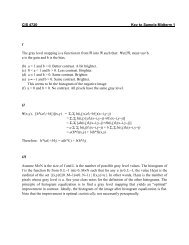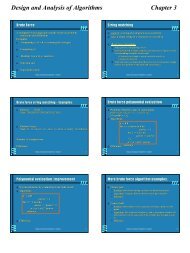Design and Analysis of Algorithms Chapter 2
Design and Analysis of Algorithms Chapter 2
Design and Analysis of Algorithms Chapter 2
Create successful ePaper yourself
Turn your PDF publications into a flip-book with our unique Google optimized e-Paper software.
<strong>Design</strong> <strong>and</strong> <strong>Analysis</strong> <strong>of</strong> <strong>Algorithms</strong> <strong>Chapter</strong> 2<br />
<strong>Analysis</strong> <strong>of</strong> <strong>Algorithms</strong><br />
Issues:<br />
• Correctness<br />
• Time efficiency<br />
• Space efficiency<br />
• Optimality<br />
Approaches:<br />
• Theoretical analysis<br />
• Empirical analysis<br />
Theoretical analysis <strong>of</strong> time efficiency<br />
Time efficiency is analyzed by determining the number <strong>of</strong><br />
repetitions <strong>of</strong> the basic operation as a function <strong>of</strong> input size<br />
Basic operation: the operation that contributes most<br />
towards the running time <strong>of</strong> the algorithm.<br />
running time<br />
input size<br />
T(n) ≈ c op C(n)<br />
execution time<br />
for basic operation<br />
Number <strong>of</strong> times<br />
basic operation is<br />
executed<br />
<strong>Design</strong> <strong>and</strong> <strong>Analysis</strong> <strong>of</strong> <strong>Algorithms</strong> - <strong>Chapter</strong> 2 1<br />
<strong>Design</strong> <strong>and</strong> <strong>Analysis</strong> <strong>of</strong> <strong>Algorithms</strong> - <strong>Chapter</strong> 2 2<br />
Input size <strong>and</strong> basic operation examples<br />
Empirical analysis <strong>of</strong> time efficiency<br />
Problem<br />
Input size measure<br />
Basic operation<br />
Select a specific (typical) sample <strong>of</strong> inputs<br />
Search for key in list <strong>of</strong> n<br />
items<br />
Number <strong>of</strong> items in list n<br />
Key comparison<br />
Use physical unit <strong>of</strong> time (e.g., milliseconds)<br />
Multiply two matrices <strong>of</strong><br />
floating point numbers<br />
Dimensions <strong>of</strong> matrices<br />
Floating point<br />
multiplication<br />
OR<br />
Compute a n<br />
n<br />
Floating point<br />
multiplication<br />
Count actual number <strong>of</strong> basic operations<br />
Graph problem<br />
#vertices <strong>and</strong>/or edges<br />
Visiting a vertex or<br />
traversing an edge<br />
Analyze the empirical data<br />
<strong>Design</strong> <strong>and</strong> <strong>Analysis</strong> <strong>of</strong> <strong>Algorithms</strong> - <strong>Chapter</strong> 2 3<br />
<strong>Design</strong> <strong>and</strong> <strong>Analysis</strong> <strong>of</strong> <strong>Algorithms</strong> - <strong>Chapter</strong> 2 4<br />
Best-case, average-case, worst-case<br />
For some algorithms efficiency depends on type <strong>of</strong> input:<br />
Worst case: W(n) – maximum over inputs <strong>of</strong> size n<br />
Best case: B(n) – minimum over inputs <strong>of</strong> size n<br />
Average case: A(n) – “average” over inputs <strong>of</strong> size n<br />
• Number <strong>of</strong> times the basic operation will be executed on typical input<br />
• NOT the average <strong>of</strong> worst <strong>and</strong> best case<br />
• Expected number <strong>of</strong> basic operations repetitions considered as a<br />
r<strong>and</strong>om variable under some assumption about the probability<br />
distribution <strong>of</strong> all possible inputs <strong>of</strong> size n<br />
<strong>Design</strong> <strong>and</strong> <strong>Analysis</strong> <strong>of</strong> <strong>Algorithms</strong> - <strong>Chapter</strong> 2 5<br />
Example: Sequential search<br />
Problem: Given a list <strong>of</strong> n elements <strong>and</strong> a search key K, , find<br />
an element equal to K, , if any.<br />
Algorithm: Scan the list <strong>and</strong> compare its successive<br />
elements with K until either a matching element is found<br />
(successful search) ) <strong>of</strong> the list is exhausted (unsuccessful(<br />
search)<br />
Worst case<br />
Best case<br />
Average case<br />
<strong>Design</strong> <strong>and</strong> <strong>Analysis</strong> <strong>of</strong> <strong>Algorithms</strong> - <strong>Chapter</strong> 2 6
<strong>Design</strong> <strong>and</strong> <strong>Analysis</strong> <strong>of</strong> <strong>Algorithms</strong> <strong>Chapter</strong> 2<br />
Types <strong>of</strong> formulas for basic operation count<br />
Exact formula<br />
e.g., C(n) ) = n(n-1)/2<br />
Formula indicating order <strong>of</strong> growth with specific<br />
multiplicative constant<br />
e.g., C(n) ≈ 0.5 n 2<br />
Formula indicating order <strong>of</strong> growth with unknown<br />
multiplicative constant<br />
e.g., C(n) ≈ cn 2<br />
Order <strong>of</strong> growth<br />
Most important: Order <strong>of</strong> growth within a constant multiple<br />
as n→∞<br />
Example:<br />
• How much faster will algorithm run on computer that is twice as fast<br />
• How much longer does it take to solve problem <strong>of</strong> double input size<br />
See table 2.1<br />
<strong>Design</strong> <strong>and</strong> <strong>Analysis</strong> <strong>of</strong> <strong>Algorithms</strong> - <strong>Chapter</strong> 2 7<br />
<strong>Design</strong> <strong>and</strong> <strong>Analysis</strong> <strong>of</strong> <strong>Algorithms</strong> - <strong>Chapter</strong> 2 8<br />
Table 2.1<br />
Asymptotic growth rate<br />
A way <strong>of</strong> comparing functions that ignores constant factors<br />
<strong>and</strong> small input sizes<br />
O(g(n)): class <strong>of</strong> functions f(n) ) that grow no faster than g(n)<br />
Θ (g(n)): class <strong>of</strong> functions f(n) ) that grow at same rate as g(n)<br />
Ω(g(n)): class <strong>of</strong> functions f(n) ) that grow at least as fast as g(n)<br />
see figures 2.1, 2.2, 2.3<br />
<strong>Design</strong> <strong>and</strong> <strong>Analysis</strong> <strong>of</strong> <strong>Algorithms</strong> - <strong>Chapter</strong> 2 9<br />
<strong>Design</strong> <strong>and</strong> <strong>Analysis</strong> <strong>of</strong> <strong>Algorithms</strong> - <strong>Chapter</strong> 2 10<br />
Big-oh<br />
Big-omega<br />
<strong>Design</strong> <strong>and</strong> <strong>Analysis</strong> <strong>of</strong> <strong>Algorithms</strong> - <strong>Chapter</strong> 2 11<br />
<strong>Design</strong> <strong>and</strong> <strong>Analysis</strong> <strong>of</strong> <strong>Algorithms</strong> - <strong>Chapter</strong> 2 12
<strong>Design</strong> <strong>and</strong> <strong>Analysis</strong> <strong>of</strong> <strong>Algorithms</strong> <strong>Chapter</strong> 2<br />
Big-theta<br />
Establishing rate <strong>of</strong> growth: Method 1 – using limits<br />
0 order <strong>of</strong> growth <strong>of</strong> T(n) ___ order <strong>of</strong> growth <strong>of</strong> g(n)<br />
lim n→∞<br />
T(n)/ )/g(n)) =<br />
c>0 order <strong>of</strong> growth <strong>of</strong> T(n) ___ order <strong>of</strong> growth <strong>of</strong> g(n)<br />
∞<br />
order <strong>of</strong> growth <strong>of</strong> T(n) ___ order <strong>of</strong> growth <strong>of</strong> g(n)<br />
Examples:<br />
•10n vs. 2n 2<br />
• n(n+1)/2 vs. n 2<br />
•log b n vs. log c n<br />
<strong>Design</strong> <strong>and</strong> <strong>Analysis</strong> <strong>of</strong> <strong>Algorithms</strong> - <strong>Chapter</strong> 2 13<br />
<strong>Design</strong> <strong>and</strong> <strong>Analysis</strong> <strong>of</strong> <strong>Algorithms</strong> - <strong>Chapter</strong> 2 14<br />
L’Hôpital’s rule<br />
If<br />
lim<br />
lim n→∞<br />
→∞ f(n) ) = lim n→∞<br />
g(n) ) = ∞<br />
The derivatives f´, g´ exist,<br />
Establishing rate <strong>of</strong> growth: Method 2 – using definition<br />
f(n) ) is O(g(n)) if order <strong>of</strong> growth <strong>of</strong> f(n) ≤ order <strong>of</strong> growth<br />
<strong>of</strong> g(n) ) (within constant multiple)<br />
There exist positive constant c <strong>and</strong> non-negative negative integer n 0<br />
such that<br />
Then<br />
lim<br />
n→∞<br />
f(n)<br />
g(n)<br />
=<br />
lim<br />
n→∞<br />
f ´(n)<br />
g ´(n)<br />
f(n) ≤ c g(n) ) for every n ≥ n 0<br />
Examples:<br />
10n is O(2n 2 )<br />
• Example: logn vs. n<br />
<strong>Design</strong> <strong>and</strong> <strong>Analysis</strong> <strong>of</strong> <strong>Algorithms</strong> - <strong>Chapter</strong> 2 15<br />
5n+20 is O(10n)<br />
<strong>Design</strong> <strong>and</strong> <strong>Analysis</strong> <strong>of</strong> <strong>Algorithms</strong> - <strong>Chapter</strong> 2 16<br />
Basic Asymptotic Efficiency classes<br />
Time efficiency <strong>of</strong> nonrecursive algorithms<br />
1<br />
log n<br />
n<br />
n log n<br />
n 2<br />
n 3<br />
2 n<br />
n!<br />
constant<br />
logarithmic<br />
linear<br />
n log n<br />
quadratic<br />
cubic<br />
exponential<br />
factorial<br />
Steps in mathematical analysis <strong>of</strong> nonrecursive algorithms:<br />
Decide on parameter n indicating input size<br />
<br />
<br />
<br />
Identify algorithm’s basic operation<br />
Determine worst, average, , <strong>and</strong> best case for input <strong>of</strong> size n<br />
Set up summation for C(n) reflecting algorithm’s loop structure<br />
Simplify summation using st<strong>and</strong>ard formulas (see Appendix A)<br />
<strong>Design</strong> <strong>and</strong> <strong>Analysis</strong> <strong>of</strong> <strong>Algorithms</strong> - <strong>Chapter</strong> 2 17<br />
<strong>Design</strong> <strong>and</strong> <strong>Analysis</strong> <strong>of</strong> <strong>Algorithms</strong> - <strong>Chapter</strong> 2 18
<strong>Design</strong> <strong>and</strong> <strong>Analysis</strong> <strong>of</strong> <strong>Algorithms</strong> <strong>Chapter</strong> 2<br />
Examples:<br />
Matrix multipliacation<br />
Matrix multiplication<br />
Selection sort<br />
Insertion sort<br />
Mystery Algorithm<br />
<strong>Design</strong> <strong>and</strong> <strong>Analysis</strong> <strong>of</strong> <strong>Algorithms</strong> - <strong>Chapter</strong> 2 19<br />
<strong>Design</strong> <strong>and</strong> <strong>Analysis</strong> <strong>of</strong> <strong>Algorithms</strong> - <strong>Chapter</strong> 2 20<br />
Selection sort<br />
Insertion sort<br />
<strong>Design</strong> <strong>and</strong> <strong>Analysis</strong> <strong>of</strong> <strong>Algorithms</strong> - <strong>Chapter</strong> 2 21<br />
<strong>Design</strong> <strong>and</strong> <strong>Analysis</strong> <strong>of</strong> <strong>Algorithms</strong> - <strong>Chapter</strong> 2 22<br />
Mystery algorithm<br />
for i := 1 to n - 1 do<br />
max := i ;<br />
for j := i + 1 to n do<br />
if |A[ j, i ]| > |A[ max, i ]| then max := j ;<br />
for k := i to n + 1 do<br />
swap A[ i, k ] with A[ max, k ];<br />
for j := i + 1 to n do<br />
for k := n + 1 downto i do<br />
A[ j, k ] := A[ j, k ] - A[ i, k ] * A[ j, i ] / A[ i, i ] ;<br />
Example Recursive evaluation <strong>of</strong> n !<br />
Definition: n ! = 1*2*…*(n<br />
*…*(n-1)* 1)*n<br />
Recursive definition <strong>of</strong> n!:<br />
Algorithm:<br />
if n=0 then F(n) ) := 1<br />
else F(n) ) := F(n-1) * n<br />
return F(n)<br />
Recurrence for number <strong>of</strong> multiplications to compute n!:<br />
<strong>Design</strong> <strong>and</strong> <strong>Analysis</strong> <strong>of</strong> <strong>Algorithms</strong> - <strong>Chapter</strong> 2 23<br />
<strong>Design</strong> <strong>and</strong> <strong>Analysis</strong> <strong>of</strong> <strong>Algorithms</strong> - <strong>Chapter</strong> 2 24
<strong>Design</strong> <strong>and</strong> <strong>Analysis</strong> <strong>of</strong> <strong>Algorithms</strong> <strong>Chapter</strong> 2<br />
Time efficiency <strong>of</strong> recursive algorithms<br />
Important recurrence types:<br />
Steps in mathematical analysis <strong>of</strong> recursive algorithms:<br />
Decide on parameter n indicating input size<br />
<br />
<br />
Identify algorithm’s basic operation<br />
Determine worst, average, , <strong>and</strong> best case for input <strong>of</strong> size n<br />
Set up a recurrence relation <strong>and</strong> initial condition(s) ) for C(n)-the<br />
number <strong>of</strong> times the basic operation will be executed for an input t <strong>of</strong> size<br />
n (alternatively count recursive calls).<br />
Solve the recurrence to obtain a closed form or estimate the order <strong>of</strong><br />
magnitude <strong>of</strong> the solution (see Appendix B)<br />
<strong>Design</strong> <strong>and</strong> <strong>Analysis</strong> <strong>of</strong> <strong>Algorithms</strong> - <strong>Chapter</strong> 2 25<br />
<br />
<br />
<br />
<br />
One (constant) operation reduces problem size by one.<br />
T(n) ) = T(n-1) + c T(1) = d<br />
Solution: T(n) ) = (n-1)(<br />
1)c + d linear<br />
A pass through input reduces problem size by one.<br />
T(n) ) = T(n-1) + cn T(1) = d<br />
Solution: T(n) ) = [n(n+[<br />
n+1)/2<br />
– 1] c + d quadratic<br />
One (constant) operation reduces problem size by half.<br />
T(n) ) = T(n/2) + c T(1) = d<br />
Solution: T(n) ) = c lg n + d<br />
logarithmic<br />
A pass through input reduces problem size by half.<br />
T(n) ) = 2T(n/2) + cn T(1) = d<br />
Solution: T(n) ) = cn lg n + d n<br />
n log n<br />
<strong>Design</strong> <strong>and</strong> <strong>Analysis</strong> <strong>of</strong> <strong>Algorithms</strong> - <strong>Chapter</strong> 2 26<br />
A general divide-<strong>and</strong><br />
<strong>and</strong>-conquer recurrence<br />
T(n) ) = aT(n/b<br />
n/b) ) + f (n) where f (n) ∈ Θ(n k )<br />
1. a < b k T(n) ∈ Θ(n k )<br />
2. a = b k T(n) ∈ Θ(n k lg n )<br />
3. a > b k T(n) ∈ Θ(n )<br />
Note: the same results hold with O instead <strong>of</strong> Θ.<br />
Fibonacci numbers<br />
The Fibonacci sequence:<br />
0, 1, 1, 2, 3, 5, 8, 13, 21, …<br />
Fibonacci recurrence:<br />
F(n) ) = F(n-1) + F(n-2)<br />
F(0) = 0<br />
F(1) = 1<br />
Another example:<br />
A(n) ) = 3A(n-1)<br />
- 2(n-2) 2) A(0) = 1 A(1) = 3<br />
2nd order linear homogeneous<br />
recurrence relation<br />
with constant coefficients<br />
<strong>Design</strong> <strong>and</strong> <strong>Analysis</strong> <strong>of</strong> <strong>Algorithms</strong> - <strong>Chapter</strong> 2 27<br />
<strong>Design</strong> <strong>and</strong> <strong>Analysis</strong> <strong>of</strong> <strong>Algorithms</strong> - <strong>Chapter</strong> 2 28<br />
Solving linear homogeneous recurrence<br />
relations with constant coefficients<br />
Easy first: 1 st order LHRRCCs:<br />
C(n) ) = a C(n -1)<br />
C(0) = t … Solution: C(n) ) = t a n<br />
Extrapolate to 2 nd order<br />
L(n) ) = a L(n-1) + b L(n-2) … A solution: L(n) ) = r n<br />
Characteristic equation (quadratic)<br />
Computing Fibonacci numbers<br />
1. Definition based recursive algorithm<br />
2. Nonrecursive brute-force algorithm<br />
3. Explicit formula algorithm<br />
Solve to obtain roots r 1 <strong>and</strong> r 2 —e.g.:<br />
A(n) ) = 3A(n-1)<br />
- 2(n-2)<br />
2)<br />
General solution to RR: linear combination <strong>of</strong> r n 1 <strong>and</strong> r<br />
n<br />
2<br />
Particular solution: use initial conditions—e.g.:<br />
e.g.:A(0) = 1 A(1) = 3<br />
<strong>Design</strong> <strong>and</strong> <strong>Analysis</strong> <strong>of</strong> <strong>Algorithms</strong> - <strong>Chapter</strong> 2 29<br />
4. Logarithmic algorithm based on formula:<br />
F(n-1)<br />
F(n)<br />
F(n)<br />
F(n+1)<br />
=<br />
0 1<br />
1 1<br />
• for n≥1, assuming an efficient way <strong>of</strong> computing matrix powers.<br />
n<br />
<strong>Design</strong> <strong>and</strong> <strong>Analysis</strong> <strong>of</strong> <strong>Algorithms</strong> - <strong>Chapter</strong> 2 30











